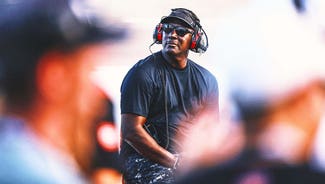
Bernard growing into job as IRL chief
Randy Bernard just laughs when asked if the reformed cowboy has officially become a gearhead.
''Definitely,'' the man charged with re-energizing IndyCar says. ''I'm a young gearhead. I can't tell you what I'm talking about yet. I don't try to. Every time I try I get in trouble. I've learned to keep my mouth shut.''
And his mind open.
Seven months into the job as IndyCar CEO, Bernard is a study in perpetual motion trying to combine on-the-job training with out-of-the box thinking.
If he's not trying to get on a first-name basis with everyone from the owners to the drivers to the pit crew members, he's traveling to Europe hoping to lure foreign auto manufacturers into joining the series.
It's been hectic. It's also been worth it.
Heading into Saturday's season-finale at Homestead-Miami Speedway, Bernard is increasingly optimistic about the future of the America's top open-wheel series. He believes there's a palpable buzz around IndyCar, one that started well before the series hired him to duplicate the rousing success he enjoyed during his 15 years as CEO of Professional Bull Riders, Inc.
''If you look at how many Facebook friends I have today compared with six months ago and read the comments, people are really behind us,'' he said.
He's doing it while attempting to marry two divergent ideas: trying to bring back the 15-20 million fans that deserted the sport in the 1990s while attracting new fans in the process.
How exactly? He's still working on it.
''That's one we've thrown up on the white board many times,'' he said.
It's a tricky process. Bernard knows the fans who turned their attention elsewhere after the series' painful split in the mid-90s ''aren't dead.'' Persuading them to return, however, won't be easy.
Two years after the series reunified, he believes the perception persists that IndyCar is a bit of a jumbled mess.
''We have to let the fan base know that it is one series now,'' he said. ''We are going to focus on attracting the best and most versatile drivers.''
That doesn't necessarily mean the best American drivers. He rejects the notion that IndyCar needs a driver draped in the stars and stripes to succeed.
''Everyone says we need more Americans and I think that would be great,'' he said. ''But we don't need just any Americans. We need the best young American drivers.''
The series is working on creating better opportunities for up-and-coming Americans to take a more direct path to IndyCar.
If it works, great. But you won't hear Bernard complaining if the series continues to be dominated by foreign-born drivers. Australian Will Power and Scottish-born Dario Franchitti head into Saturday night's 300-mile finale chasing the points title.
Bernard isn't playing favorites, arguing both drivers have good stories to tell. The 29-year-old Power's career nearly ended following a horrific crash in Sonoma last summer, while the 37-year-old Franchitti will try to join Sam Hornish Jr. as the only three-time IndyCar champion.
''It's the young guy versus the veteran,'' he said. ''I hope it's a great race.''
Either way, it will be the last one at Homestead, at least for the near future. The track was left off the revamped 2011 schedule, as were the other tracks operated by International Speedway Corp., which has close ties to NASCAR.
In their place are new venues like Baltimore and New Hampshire, as well as a return to Milwaukee and a possible season-ending race in Las Vegas.
On the surface it appears IndyCar is aligning itself with ISC-rival Speedway Motorsports Inc., whose tracks will host at least four races in 2011. While Bernard is quick to praise SMI owner Bruton Smith for working closely with IndyCar, he isn't ready to rule out racing at ISC venues down the road.
''We will never close the door on ISC,'' he said. ''I think it's important that we continue our relationship. But we've given 17 promoters the opportunity to prove themselves. Regardless if we have ISC tracks or not, our first and foremost priority is to make sure that those events are successful.''
And that means putting fans in seats. Even the most cagey TV director would have difficulty masking the obvious scads of empty seats found at most races this year, though IndyCar is hardly the only sport affected by the economic downturn.
Bernard allows that he'd like to see more people in the stands, but points out there are more eyes tuning in on Versus. Ratings have increased 26 percent over a year ago, and are up 40 percent in the coveted 18- to 34-male demographic.
Then again, the numbers had little place to go but up on the network, which reaches 75 million homes compared to the over 100 million reached by ESPN. They have little choice but to make it work. There are eight years left on the current contract between the series and the network.
''We're kidding ourselves if we think that's the perfect home for us, you always want to be in 120 million homes,'' he said. ''But we're on an aggressive network that we have an opportunity to grow with.''
It's hardly the only area where the series is looking for growth. Bernard spent nearly two weeks in Europe hoping to persuade auto manufacturers to start building a chassis for IndyCar to give Honda, which has made all the engines in the series for the better part of a decade, some competition.
His goal is to bring one or two new manufacturers to the series in 2012, when the redesigned car debuts. He's not putting odds on it just yet.
''For me to say (my pitch) was successful, I'd be kidding myself,'' he said. ''But I think we made good progress.''
And for now, that'll do.

